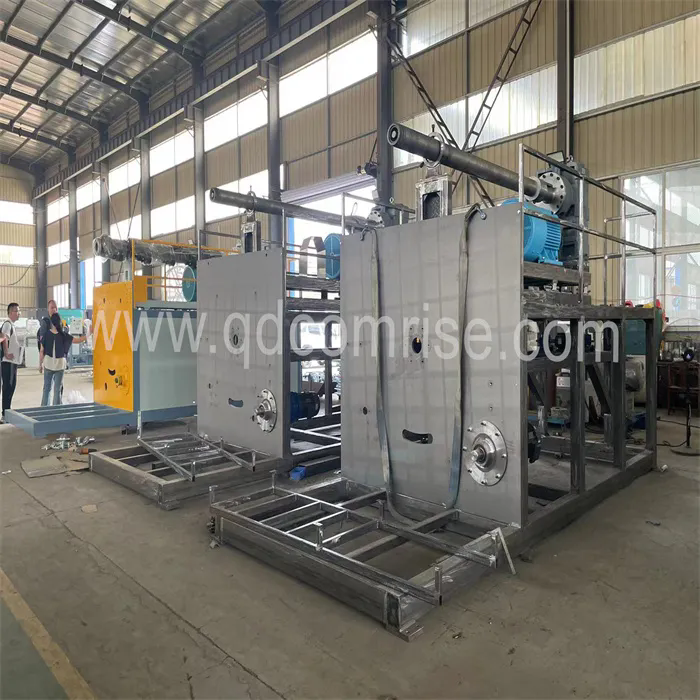Solid Wall Pipe Production Line: The Backbone of Modern Pipe Manufacturing
2024-09-13
The demand for durable, reliable, and versatile piping solutions has grown exponentially across various industries, from construction to agriculture and infrastructure. A key component in meeting this demand is the solid wall pipe production line, a sophisticated manufacturing system designed to produce high-quality pipes used for a wide range of applications. In this blog post, we will explore what a solid wall pipe production line is, how it works, and its significance in modern pipe manufacturing.
What is a Solid Wall Pipe Production Line?
A solid wall pipe production line is an industrial setup designed to manufacture solid-wall pipes, typically made from materials like PVC, HDPE (High-Density Polyethylene), and PP (Polypropylene). These pipes are known for their durability, strength, and resistance to chemicals, making them ideal for various uses such as water supply, sewage systems, irrigation, and industrial applications.
The production line automates the entire process, from raw material feeding to extrusion, cooling, cutting, and stacking, ensuring consistent quality and efficiency in large-scale production.
The Working Process of a Solid Wall Pipe Production Line
1. Material Feeding and Preparation
The process begins with feeding raw materials like PVC, HDPE, or PP into the system. The raw material is typically in the form of granules or powder, which are fed into the extruder via a hopper. Before the material reaches the extruder, additives such as stabilizers, lubricants, and coloring agents may be mixed in to enhance the pipe's properties and performance.
2. Extrusion
At the core of the solid wall pipe production line is the extruder, where the raw materials are melted and molded into the desired pipe shape. The extruder uses a rotating screw inside a heated barrel to melt the plastic, pushing it through a die that shapes the pipe. The die is specifically designed to produce solid-wall pipes of varying diameters, depending on the requirements.
3. Vacuum Calibration and Cooling
Once the pipe exits the die, it enters the vacuum calibration tank, where it is cooled and shaped to precise dimensions. The vacuum tank ensures that the pipe maintains its correct diameter and roundness. After calibration, the pipe moves through a series of water-cooling tanks to solidify the plastic and enhance the pipe's mechanical properties.
4. Haul-Off Unit
The haul-off unit is responsible for pulling the newly formed pipe from the cooling tanks at a consistent speed. This unit ensures smooth transportation of the pipe through the production line while maintaining the desired pipe thickness and uniformity.
5. Cutting and Stacking
After the pipe reaches the desired length, an automated cutting machine slices the pipe to the specified dimensions. Once cut, the finished pipes are stacked or coiled, depending on their size, for storage or transportation. Some production lines also have automated labeling and printing systems to mark the pipes with important information such as diameter, material type, and production date.
6. Quality Control
Throughout the process, various quality control checks are performed to ensure the pipes meet industry standards and customer specifications. This can include checks for wall thickness, surface finish, dimensional accuracy, and mechanical strength.
Key Benefits of Solid Wall Pipe Production Lines
1. High Efficiency and Automation
Modern solid wall pipe production lines are fully automated, ensuring high production efficiency and minimal human intervention. This results in faster production times and lower labor costs, while maintaining consistent product quality.
2. Customization and Flexibility
Solid wall pipe production lines are highly customizable, allowing manufacturers to produce pipes of different diameters, lengths, and materials to meet the specific needs of various industries. Whether you need pipes for potable water, gas distribution, or sewage systems, these production lines can be adjusted to meet those requirements.
3. Durable and Long-Lasting Products
Solid wall pipes produced by these lines are known for their durability and longevity. Thanks to the precise extrusion process and material formulations, the resulting pipes are highly resistant to chemicals, corrosion, and environmental stress, ensuring long-term performance in harsh conditions.
4. Environmentally Friendly
Many solid wall pipe production lines are designed to minimize waste and energy consumption. HDPE and PVC materials are recyclable, making these production systems a more environmentally friendly option for manufacturers who prioritize sustainability.
5. Cost-Effective Solutions
The automated nature of solid wall pipe production lines reduces the overall cost of production. Combined with the long service life of the pipes, this makes them a cost-effective solution for industries that need durable piping systems.
Applications of Solid Wall Pipes
Solid wall pipes produced by these lines are used in a wide range of applications due to their versatility, durability, and resistance to various environmental factors. Some common applications include:
1. Water Supply Systems
Solid wall pipes made from HDPE or PVC are often used in potable water supply systems. Their corrosion-resistant properties and smooth internal surfaces ensure the safe and efficient delivery of water over long distances.
2. Sewage and Drainage Systems
Solid wall pipes are ideal for sewage, stormwater, and drainage systems due to their strength and ability to withstand the harsh conditions of wastewater transport.
3. Agricultural Irrigation
In agriculture, solid wall pipes are used for irrigation systems, helping farmers distribute water efficiently to their crops. HDPE pipes, in particular, are favored for their flexibility and resistance to cracking.
4. Industrial and Chemical Piping
The chemical resistance of solid wall pipes makes them suitable for transporting various industrial liquids and gases, including corrosive substances that would damage traditional metal piping systems.
5. Electrical and Telecommunication Conduits
Solid wall pipes are also used as protective conduits for electrical cables and fiber optic lines, ensuring safe and efficient cable management in both commercial and residential settings.
Conclusion
The solid wall pipe production line is a vital part of the modern manufacturing landscape, providing industries with the reliable, durable, and efficient piping solutions they need. With its high level of automation, flexibility, and ability to produce high-quality pipes from various materials, this production line has become the backbone of many critical applications, from water supply and sewage systems to industrial and chemical piping.
As industries continue to grow and evolve, solid wall pipe production lines will remain a key player in meeting the demand for high-performance piping systems.



